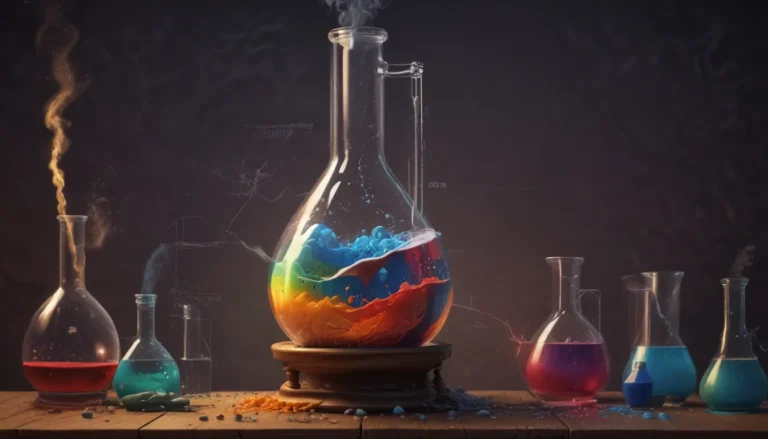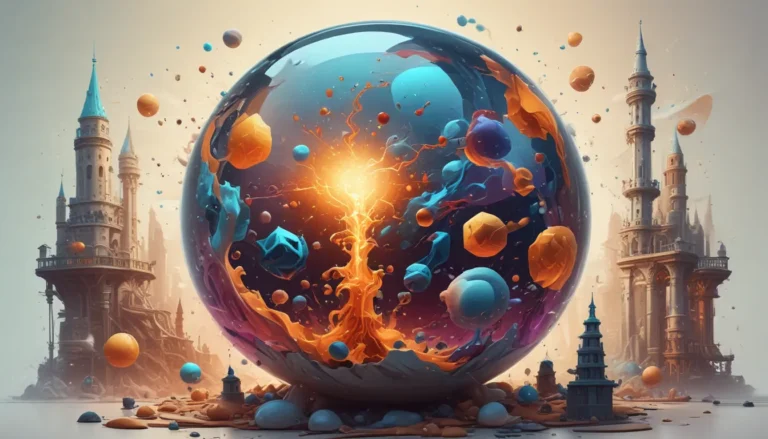A Note About Images: The images used in our articles are for illustration purposes only and may not exactly match the content. They are meant to engage readers, but the text should be relied upon for accurate information.
Welcome to the world of compounds, where the building blocks of matter come together to create a diverse array of substances that shape our daily existence. Compounds are the fundamental components that make up everything around us, from the air we breathe to the water we drink. In this article, we will unravel the fascinating world of compounds and explore their properties, significance, and impact on our lives. Let’s dive into 15 intriguing facts about compounds that will broaden your understanding of these essential elements.
Unveiling the Definition of Compounds
At the core of chemistry lies the concept of compounds, which are substances composed of two or more different elements chemically bonded together. These elements combine in specific ratios to form unique compounds with distinct properties. This bonding process gives rise to a vast array of compounds, each with its own set of characteristics and behaviors.
The Vast Spectrum of Compounds
The world of compounds is abundant and diverse, encompassing a wide range of substances that vary in complexity and composition. From simple compounds like water (H2O) and salt (NaCl) to the intricate structures found in pharmaceuticals, plastics, and natural compounds, the spectrum of compounds is truly remarkable. These compounds form the very fabric of our surroundings, contributing to the richness and complexity of the world we inhabit.
Delving into Chemical Bonding
Chemical bonding serves as the glue that holds elements together to form compounds. Two primary types of chemical bonding govern these interactions: ionic bonding and covalent bonding. Ionic bonding involves the transfer of electrons between elements, while covalent bonding entails the sharing of electrons. These bonding mechanisms dictate the nature of the compounds that are formed and influence their properties and behavior.
Embracing the Importance of Compounds in Nature
Compounds play a vital role in sustaining life as we know it. Organic compounds, which contain carbon, hydrogen, and other elements, form the foundation of all living organisms. Essential biomolecules such as carbohydrates, proteins, lipids, and nucleic acids are composed of organic compounds and are crucial for the functioning of living systems. The intricate web of compounds present in nature underscores their significance in supporting life processes.
Unveiling the World of Synthetic Compounds
While many compounds occur naturally, there are also synthetic compounds that are created through chemical reactions. These artificially produced compounds have a wide range of applications in various industries, including the manufacture of synthetic fibers, pharmaceutical drugs, and industrial chemicals. The ability to synthesize compounds has expanded the scope of materials available to us and has paved the way for innovative advancements in technology and manufacturing.
Water: The Extraordinary Universal Solvent
Water stands out as one of the most remarkable compounds due to its unique properties. Known as the universal solvent, water has the remarkable ability to dissolve a vast array of substances, making it indispensable for biological processes and everyday activities. The solvent properties of water enable it to facilitate essential chemical reactions, transport nutrients within living organisms, and support various environmental processes.
Understanding Carbon Dioxide and Global Warming
Carbon dioxide (CO2) is a compound that plays a critical role in the complex phenomenon of climate change. The excessive release of CO2 into the atmosphere, primarily from human activities such as the burning of fossil fuels, contributes to the greenhouse effect and global warming. The impact of CO2 on the Earth’s climate underscores the interconnected relationship between compounds and environmental processes.
Exploring Chemical Reactions and Compound Formation
Chemical reactions lie at the heart of compound formation, involving the breaking and forming of chemical bonds between atoms. These reactions give rise to new compounds with distinct properties and behaviors. Whether observed in the natural world or replicated in laboratory settings, chemical reactions drive transformations and underpin the dynamic nature of compounds.
Decoding the Language of Chemical Formulas
Chemical formulas serve as the blueprint for compounds, offering insights into their composition and structure. These formulas employ symbols to represent elements and subscripts to indicate the number of atoms of each element in a compound. For instance, the formula H2O signifies water, comprising two hydrogen atoms and one oxygen atom. Chemical formulas provide a concise and standardized way of representing compounds and conveying essential information about their identity.
Unveiling the Unique Properties of Compounds
Compounds exhibit a diverse array of properties that set them apart from their constituent elements. These properties encompass characteristics such as melting and boiling points, solubility, reactivity, and color, among others. The specific combination of elements within a compound dictates its distinct set of properties, underscoring the complex interplay between composition and behavior in the realm of compounds.
Contrasting Ionic and Covalent Compounds
Ionic and covalent compounds represent two distinct classes of compounds with differing characteristics. Ionic compounds typically possess high melting and boiling points and can conduct electricity when dissolved in water. In contrast, covalent compounds tend to have lower melting and boiling points and do not conduct electricity in their pure form. The unique properties exhibited by these compounds reflect the nature of their chemical bonding and structural arrangements.
Spotlight on Compounds in Everyday Products
The ubiquity of compounds in everyday products underscores their pervasive presence in our lives. From personal care products like soap to household items such as plastic containers, compounds serve a multitude of purposes and fulfill essential functions in meeting our daily needs. The incorporation of compounds in various consumer goods highlights their versatility and relevance in modern society.
Marveling at Crystal Structures in Compounds
Certain compounds exhibit intricate crystal structures characterized by orderly arrangements of atoms. These structures give rise to crystals that exhibit unique shapes and properties, making them valuable for applications in jewelry and decorative items. The allure of crystal structures in compounds showcases the aesthetic appeal and structural complexity inherent in the world of compounds.
Navigating Chemical Stability in Compounds
Compounds vary in their stability, with some exhibiting high stability and resistance to chemical reactions, while others are more reactive and prone to interacting with other substances. The concept of chemical stability underscores the dynamic nature of compounds and the diverse range of behaviors they can exhibit. Understanding the stability of compounds is crucial for predicting their reactivity and assessing their suitability for specific applications.
Unraveling the Mystery of Compound Analysis
Scientists employ a range of techniques to analyze compounds and unravel their composition and structure. Techniques such as spectroscopy, chromatography, and X-ray crystallography provide valuable insights into the properties and behavior of compounds, enabling researchers to investigate their molecular intricacies. The process of compound analysis serves as a gateway to understanding the underlying principles governing compound formation and behavior, unlocking new avenues for exploration and discovery.
Embracing the Complexity of Compounds
In conclusion, delving into the captivating world of compounds offers a glimpse into the complexity and diversity of matter that surrounds us. These essential entities shape our environment, drive scientific advancements, and influence various facets of our daily lives. By unraveling the mysteries of compounds and appreciating their critical role in the world, we gain a deeper understanding of the interconnected nature of the universe and the significance of compounds in shaping our reality.
Conclusion
As we journey through the realm of compounds, we uncover a tapestry of knowledge and insights that enrich our understanding of the world around us. From the intricate chemical bonding that defines compound formation to the diverse properties that distinguish compounds from their constituent elements, the world of compounds offers a treasure trove of discoveries waiting to be explored. By embracing the complexity and diversity of compounds, we embark on a voyage of discovery that unveils the wonders of the natural world and deepens our appreciation for the fundamental components of matter.
Frequently Asked Questions
What are some common examples of compounds?
- Water (H2O)
- Salt (NaCl)
- Carbon dioxide (CO2)
- Glucose (C6H12O6)
- Methane (CH4)
How are compounds different from elements?
- Compounds are comprised of two or more different elements chemically bonded together, while elements consist of only one type of atom.
Can compounds be separated into their constituent elements?
- Yes, compounds can be separated into their constituent elements through chemical reactions, a process known as decomposition.
What is the significance of compounds in industries?
- Compounds play a crucial role in various industries, including pharmaceuticals, manufacturing, agriculture, and technology. They are used to create medicines, plastics, fertilizers, and electronic devices, among many other applications.
Are all compounds safe for consumption or use?
- Not all compounds are safe for consumption or use, as some may be toxic, hazardous, or subject to specific restrictions. It is important to adhere to safety guidelines and regulations when handling compounds to ensure responsible usage.
As we navigate the realm of compounds, let’s embark on a journey of discovery and exploration that unveils the marvels and mysteries of these essential elements. Through a deeper understanding of compounds and their significance in our world, we gain a newfound appreciation for the intricate tapestry of matter that surrounds us. Join us on this captivating odyssey as we unravel the wonders of compounds and uncover the secrets that shape our reality.






